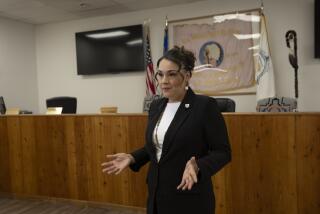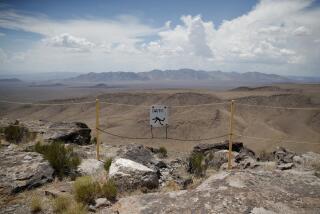Bullfrog, Nevada : Empty County to Croak Unless It Goes to Waste
- Share via
BULLFROG COUNTY, Nev. — Bob Revert drove his four-wheel-drive pickup off Highway 95 and headed east for 14 miles in a cloud of dust across open desert, over an unmarked dirt trail full of rocks and chuckholes, to reach America’s newest county.
Revert had taken the easiest ground route to Bullfrog County, the only county in the United States without people. It is, instead, a county populated by rattlesnakes, kangaroo rats, lizards, coyotes, lynx cats and a variety of other wildlife thriving in the sun-drenched desert dotted with sagebrush and creosote bushes.
Not Much There
It has no roads, no buildings, no hotels, motels or even a tree to sleep under. No churches, cemeteries, schools. It’s the only county in Nevada without slot machines, crap tables or gambling of any kind. No signs tell you when you are entering or leaving Bullfrog County.
There isn’t one inch of private land in the 12-mile-long, 12-mile-wide county made up almost entirely of Yucca Mountain, a huge volcanic mesa rising starkly from the desert floor 115 miles northwest of Las Vegas. It all belongs to Uncle Sam. Half of the county is part of the Department of Energy’s Nevada Test Site, one-fourth is Nellis Air Force Base’s gunnery range and one-fourth is administered by the Bureau of Land Management.
Offspring of Nye County
Bullfrog County is a remote slice of desert wilderness carved out of Nye County by an act of the Nevada Legislature passed at 3 a.m. on June 18 during the final hours of the 1987 legislative session. A few days later Gov. Richard H. Bryan signed the bill making the bizarre county a political reality.
“Watch out for rattlesnakes,” Revert, a Nye County commissioner, shouted to two newsmen as they left the pickup to stretch their legs on the lower slopes of Yucca Mountain.
As far as the three men knew, they were the only visitors that day anywhere in the county, one of the strangest political subdivisions ever created. The only sounds in the eerie quiet were occasional gusts of wind blowing tumbleweed down the mountain.
Bullfrog County, with a landscape like the surface of the moon, is a creation of the Nuclear Age--and Nevada politics.
State Assemblyman Paul May of Las Vegas, chairman of the Assembly Taxation
Committee, first got the idea when he was looking for additional revenue for the state. May realized that millions of federal dollars would pour into Nye County if Yucca Mountain were chosen as the nation’s first high-level nuclear waste repository. Yucca Mountain is a finalist with Deaf Smith County, Tex., and Hanford, Wash., for construction of the $2-billion facility.
Why, May asked, should Nye County receive all that money? Bullfrog County--named after an old gold mine and controlled by the state--was the result.
The Assembly voted, 32 to 9, for the county; the Senate did the same on a 14-7 vote. Since the Nevada Legislature has the right to form and dissolve counties, the people of Nye County--population 14,000-- had no opportunity to vote on the matter.
‘Not a County Issue’
“This is a statewide issue, not a county issue,” May said in an interview. May noted that he and “nearly all of Nevada’s elected officials are dead set against having a nuclear dump in our state. But if it happens, it would seem tragic not to take the federal government for all the money possible.”
The Nuclear Waste Policy Act of 1982 provides that the federal government will allow itself to be taxed at the dump site as though it were a private corporation. “Nye County’s tax rate is $1.62 per $100 assessed valuation,” May explained. “In Bullfrog County the rate is the maximum, $5 per $100, more than three times that of Nye County. The . . . revenue from the federal government will be distributed throughout the state in a fair and equitable manner.”
On Monday, Gov. Bryan announced the appointment of three Bullfrog County commissioners: Mike Melner, a Reno attorney; Dorothy Eisenberg of Las Vegas, past president of the League of Women Voters of Clark County, and David Powell, a Las Vegas real estate broker. Each will receive $1 a year. The governor said he will name other county officials, including a sheriff, later. Carson City, Nevada’s capital, 270 miles to the north, has been designated Bullfrog’s county seat.
“By creating Bullfrog County, a county without people,” May said, “the federal government will be dealing directly with the state instead of Nye County on any matters pertaining to the nuclear waste dump. Bullfrog County will be administered by the governor’s office. It will be state-run, state-oriented, state-controlled.
“If the new nuclear waste repository is not located in Bullfrog County, the legislative act creating it will be dissolved and the county returned back to Nye County.”
In a press conference after his appointment as Bullfrog County commissioner, Melner said the first order of business for the commissioners will be to pass a resolution opposing a high-level nuclear repository in Nevada. “We want Washington to know Nevada speaks with one voice. We do not want our state to become a garbage dump for the rest of the nation,” Melner said.
“That big old mountain is solid rock,” Revert mused as he stood at the foot of Yucca Mountain. “If Yucca Valley is selected, vertical shafts will be drilled . . . from the top into the heart of the mountain feeding off into a network of horizontal tunnels, storage areas for spent nuclear rods held in canisters.”
Revert owns and operates three gas stations and a mini-market in the desert community of Beatty, population 1,200, which is 20 miles northwest of Bullfrog County.
“The majority of the people of Beatty and Nye County favor the location of the nuclear dump here. It will bring tremendous economic benefits. . . .”
He argues that although Bryan has publicly opposed a nuclear waste site in Nevada, he sent the opposite signal to Washington when he signed the bill creating Bullfrog County.
On Aug. 5, Joe S. Garcia Jr., Nye County Commission chairman, wrote Bryan, requesting a special one-day session of the Legislature to repeal Bullfrog County. “By creating Bullfrog County, it may have sealed Nevada’s fate with the repository,” Garcia wrote.
Bryan quickly rejected the suggestion, contending that “Bullfrog County was created to try to prevent Nye County from making an end run and saying we want this dump site.” Nye County commissioners have taken no stand on the repository.
Phil Donleavy, Nye County district attorney, is preparing a lawsuit challenging the constitutionality of Bullfrog County.
“The state has stolen land from this county,” he charged. “There is no precedent for this immoral act based on greed to create a phantom county, a legal nightmare. The state created a no-man’s land where crimes can be committed and criminals not be prosecuted.”
Under the federal plan, high-level nuclear waste from the nation’s 100 commercial nuclear power plants would be consolidated at a single site, deep in an underground geological formation.
To find the best location, the Department of Energy will construct a 12-foot-wide, 1,200-foot-deep shaft at each of the three potential sites. Each shaft will cost $500 million, said Chris West, director of external affairs for the Energy Department at the Nevada operations office in Las Vegas.
“The purpose is to study the hydrology and geology at each site, to look for cracks, to look for the difference in rock types not detected by core samples,” West said.
Construction of the test shafts at Yucca Mountain will not begin until next summer at the earliest, West said, with testing continuing for five or six years. It will take eight to 10 years, and at least 2,000 people, to build the repository. He said the repository probably would not be put on line before the year 2003. The facility will employ about 1,000, West said.
Amargosa Valley is the closest town to Yucca Mountain and the proposed nuclear waste repository. The town limits are six miles from Bullfrog County.
“We were given the shaft,” Betty Jo Boyd, a town leader, said of the Bullfrog County legislation.
Bill Copeland, 53, a truck driver and chairman of the five-member town board, said the people of Amargosa (meaning bitter water) have been looking forward to the nuclear dump for a long time. “Revenues received by Nye County would be used to improve the quality of our life style by bringing more people in this area,” he said.
The town lost two-thirds of its population when American Borate Corp. closed its plant 18 months ago. The population is now less than 1,000, mostly alfalfa farmers and Nevada Test Site employees.
More to Read
Sign up for The Wild
We’ll help you find the best places to hike, bike and run, as well as the perfect silent spots for meditation and yoga.
You may occasionally receive promotional content from the Los Angeles Times.






